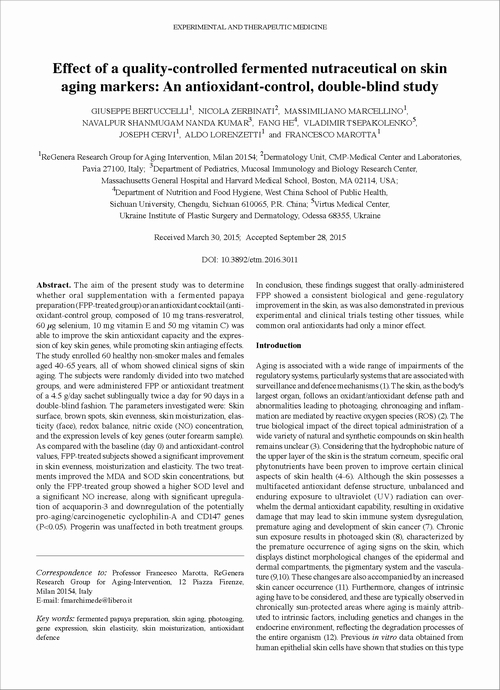News&Topics
Research
2016/04/01ResearchResearch Results
FPP Clinical Paper on prevention of skin aging has been published.
FPP Clinical Paper on prevention of skin aging has been published.
Effect of a quality-controlled fermented nutraceutical on skin aging markers:An antioxidant-control, double-blind study
EXPERIMENTAL AND THERAPEUTIC MEDICINE.

The aim of the present study was to determine whether oral supplementation with a fermented papaya preparation (FPP treated group) or an antioxidant cocktail (antioxidant control group, composed of 10 mg trans resve¬ratrol, 60 μg selenium, 10 mg vitamin E and 50 mg vitamin C) was able to improve the skin antioxidant capacity and the expression of key skin genes, while promoting skin antiaging effects.
The study enrolled 60 healthy non smoker males and females aged 40 65 years, all of whom showed clinical signs of skin aging. The subjects were randomly divided into two matched groups, and were administered FPP or antioxidant treatment of a 4.5 g/day sachet sublingually twice a day for 90 days in a double blind fashion.
The parameters investigated were: Skin surface, brown spots, skin evenness, skin mois¬turization, elasticity (face), redox balance, nitric oxide (NO) concentration, and the expression levels of key genes (outer forearm sample).
As compared with the baseline (day 0) and antioxidant control values, FPP treated subjects showed a significant improvement in skin evenness, moisturization and elasticity. The two treatments improved the MDA and SOD skin concentrations, but only the antioxidant control group showed a higher SOD level and a significant NO increase, along with significant upregulation of acquaporin 3 and downregulation of the potentially pro aging/carcinogenetic (casinogenic?) cyclophilin A and CD147 genes. Progerin was unaffected in both treatment groups.
In conclusion, these findings suggest that orally administered FPP showed a consistent biological and gene regulatory improvement in the skin, as was also demonstrated in previous experimental and clinical trials testing other tissues, while common oral antioxidants had only a minor effect.
